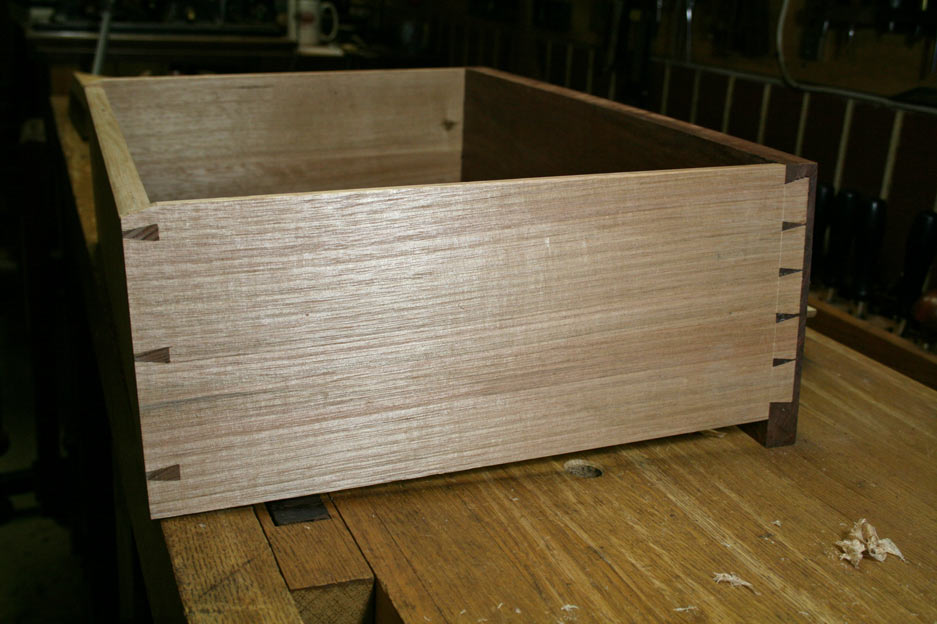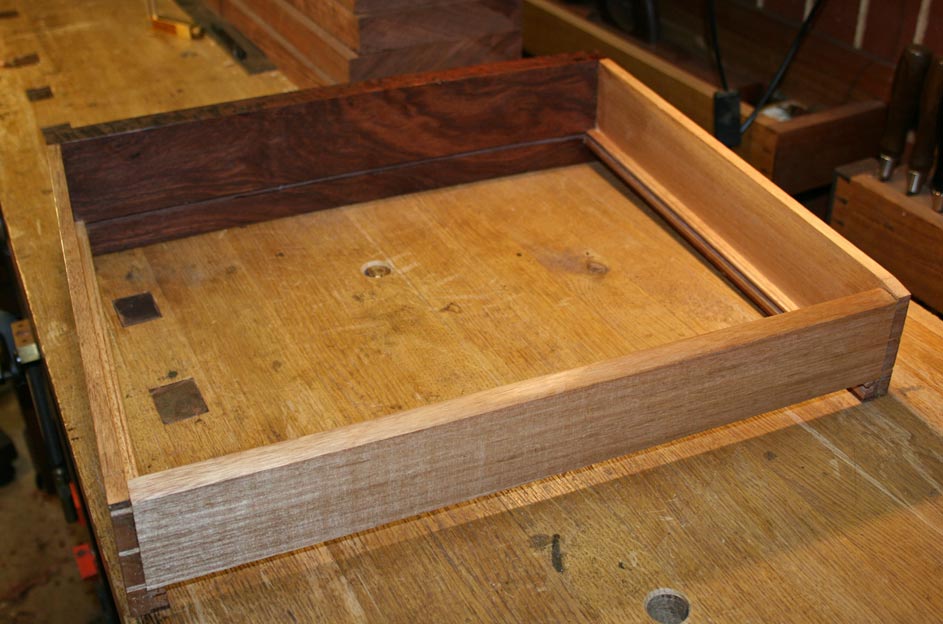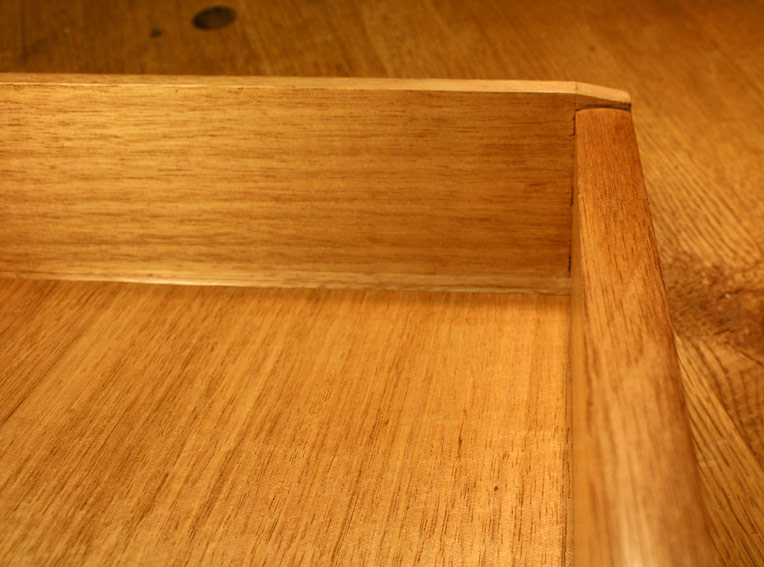 Needs Pictures: 0
Needs Pictures: 0
 Picture(s) thanks: 0
Picture(s) thanks: 0
Results 1 to 15 of 29
-
25th May 2017, 07:56 PM #1
 Dovetail Drawers - what on the rear? Consensus?
Dovetail Drawers - what on the rear? Consensus?
Im about to make a few drawers with half blind dovetails on the front.
Ive found quite a few pix on what joint is generally used on the back, but it seems there is little text as to why certain styles are chosen.
Anyone know or can point me to what the preferential treatment is?
Sides and Front is 18mm. Back is yet undecided.
-
25th May 2017 07:56 PM # ADSGoogle Adsense Advertisement
- Join Date
- Always
- Location
- Advertising world
- Posts
- Many
-
25th May 2017, 08:21 PM #2
 GOLD MEMBER
GOLD MEMBER











- Join Date
- Aug 2011
- Location
- bilpin
- Posts
- 3,559

A quality job will have dovetails all round. The rear can be through as they are not seen.
-
25th May 2017, 08:38 PM #3

I use half-blind dovetails on the front of drawers, generally about 20mm thick. Sides are between 6 - 8mm, typically with slips for the drawer bottoms rather than grooves, and the rear is a through dovetail, typically on 10 - 12mm backs. The back does not take the stress of the front, so fewer dovetails are needed.

Link: http://www.inthewoodshop.com/Furnitu...ovetails3.html
Regards from Perth
DerekVisit www.inthewoodshop.com for tutorials on constructing handtools, handtool reviews, and my trials and tribulations with furniture builds.
-
25th May 2017, 08:47 PM #4
 Woodworking mechanic
Woodworking mechanic











- Join Date
- Jan 2014
- Location
- Sydney Upper North Shore
- Posts
- 4,470

Derek, do you slip the sides and groove the front or use slips all round?
-
25th May 2017, 09:03 PM #5

Only slips the sides. The front has a groove, and the slips align with that.
Here is an example, with the rear facing you ...

Another, where you can see the drawer bottom aligned with (beaded) drawer slips (the slips are flush with the drawer bottom) ...

Two more photos, one of the fitting at the rear, and the other a side profile ..


Link: http://www.inthewoodshop.com/Furniture/BuildingTheDrawers.html
Regards from Perth
DerekVisit www.inthewoodshop.com for tutorials on constructing handtools, handtool reviews, and my trials and tribulations with furniture builds.
-
25th May 2017, 09:54 PM #6

Slips. I saw these on Wongos recent drawers and some out at the Bungendore woodworks.
This is going to sound stupid, but do you put the drawers bottom by sliding it in from the back, along the "slips" and then into the slot at the front?
Id imagine you secure the bottom with a staple or nail?
Last question Ive been doing my slots on the tablesaw, but it obviously goes right along from side to side. Do you do this but hide the slot in the inside of the pin-negative?
Ive been doing my slots on the tablesaw, but it obviously goes right along from side to side. Do you do this but hide the slot in the inside of the pin-negative?
Sorry for such stupid questions.
-
25th May 2017, 10:06 PM #7

look what I found
 , but all the images are dead: The Devil lies in the details
, but all the images are dead: The Devil lies in the details
edit: god damn! you keep coming up with every google image I click on! http://www.inthewoodshop.com/Furnitu...erBottoms.html
Search on "drawers slips design" and pow! relentlessly up comes our Mr Cohen!
-
25th May 2017, 11:30 PM #8

WP, what can I say ..

Here is the Furniture Building Index on my website: Furniture
You will find lots of related articles there.
Regards from Perth
DerekVisit www.inthewoodshop.com for tutorials on constructing handtools, handtool reviews, and my trials and tribulations with furniture builds.
-
26th May 2017, 08:55 AM #9

The method used by Derek was (is?) taught at Sturt and is a very neat way of meeting the structural and aesthetic requirements for a drawer.
Regarding the front & rear dovetails, I recently had the opportunity to see an 18th century cabinet that had been in continuous use. the drawers had half-blind dovetails at the front, through dovetails at the rear, and was as sound as the day it was built.
-
26th May 2017, 10:37 AM #10

Maybe my cabinets will get 200 years of use

Certainly makes it look cheap when amortised on a yearly basis.
I'd like to thank Derek and Alex, you have provided a lot of highly valuable info on many things box and furniture related.
Of interest, for I didn't think Id ever do this, but I've ordered a set of Veritas dovetail saws, some low angle planes and a couple of marking gauges. They are yet to come. A nice bench, a wood screw vice (yess!!!) and a bit of a build and I'll be back in the 18thC myself
Curious! For a considerable time there was no way I was going to go down this path!
-
26th May 2017, 11:25 AM #11

Well, slips it is! They actually look a lot easier to make.
I like this quote on Dereks site: "Marks refers to the panel-into-a-groove as the "Kitchen drawer", so called as it was "the cheapening of quality construction to the extreme"."
Dont want to be accused of being extreme or cheap
Strange that the front fits into a groove and not its own slip That would make things easier
That would make things easier 
-
26th May 2017, 03:14 PM #12

WP, what were often referred to in the UK in the past as drawers for "fine furniture" were those with sides about 1/4" to max 3/8" thick. Thin drawers were/are considered more elegant. In the USA furniture has tended to build drawers with sides 1/2" thick and up. Drawers with thicker sides were quicker to build as they may be grooved. The thin UK drawers cannot, and necessitated slips. Some referred to the thicker drawers as "kitchen drawers". I guess, if one follows the American school and videos, then the mindset is to build drawers with grooves in the drawer sides.
I am not saying that grooves in sides is poor form - just that there are two schools of thought.
Grooves at the front are possible because the front is so much thicker than the sides.
Regards from Perth
DerekVisit www.inthewoodshop.com for tutorials on constructing handtools, handtool reviews, and my trials and tribulations with furniture builds.
-
26th May 2017, 03:44 PM #13
 GOLD MEMBER
GOLD MEMBER











- Join Date
- Apr 2014
- Location
- Little River
- Age
- 78
- Posts
- 1,205

A request to derekcohen.
Could you please explain to those of us that have not been lucky enough to handle or build fine furniture drawers the dimensions of these slips and how they are attached to the drawer sides, how the bottoms of the drawers are then fitted.
-
26th May 2017, 04:52 PM #14

Hi Bohdan
Think of the slips as a tongue-and-groove joint. The slip is grooved, and the drawer bottom fits into the groove with a tongue.
I build slips by playing a groove into the end of a board, then slicing off the end (= grooved batten).
The end of the slip is shaped so that it has a small tenon, and this will fit into the groove at the back of the drawer front so that it lines up ...

Below is a picture I posted earlier. What I want to point out here is that the slip is alighed with the drawer back in such a way that the drawer bottom slides under the back. The drawer bottom is slid along the slips from the back and into the groove at the front, and then secured with a screw.

Regards from Perth
DerekVisit www.inthewoodshop.com for tutorials on constructing handtools, handtool reviews, and my trials and tribulations with furniture builds.
-
26th May 2017, 05:47 PM #15
 GOLD MEMBER
GOLD MEMBER











- Join Date
- Apr 2014
- Location
- Little River
- Age
- 78
- Posts
- 1,205

What holds the slip against the side? Is it just glue and the pin in the groove?
Similar Threads
-
Rear Verandah - WIP
By Glenn.Visca in forum FURNITURE, JOINERY, CABINETMAKING - formerly BIG STUFFReplies: 29Last Post: 9th August 2016, 12:12 AM -
rear toolpost ..how ?
By morrisman in forum METALWORK FORUMReplies: 6Last Post: 7th November 2011, 08:05 PM -
Consensus on this
By MICKYG in forum TABLE SAWS & COMBINATIONSReplies: 3Last Post: 10th March 2010, 01:21 PM



 Thanks:
Thanks:  Likes:
Likes: 
 Reply With Quote
Reply With Quote
